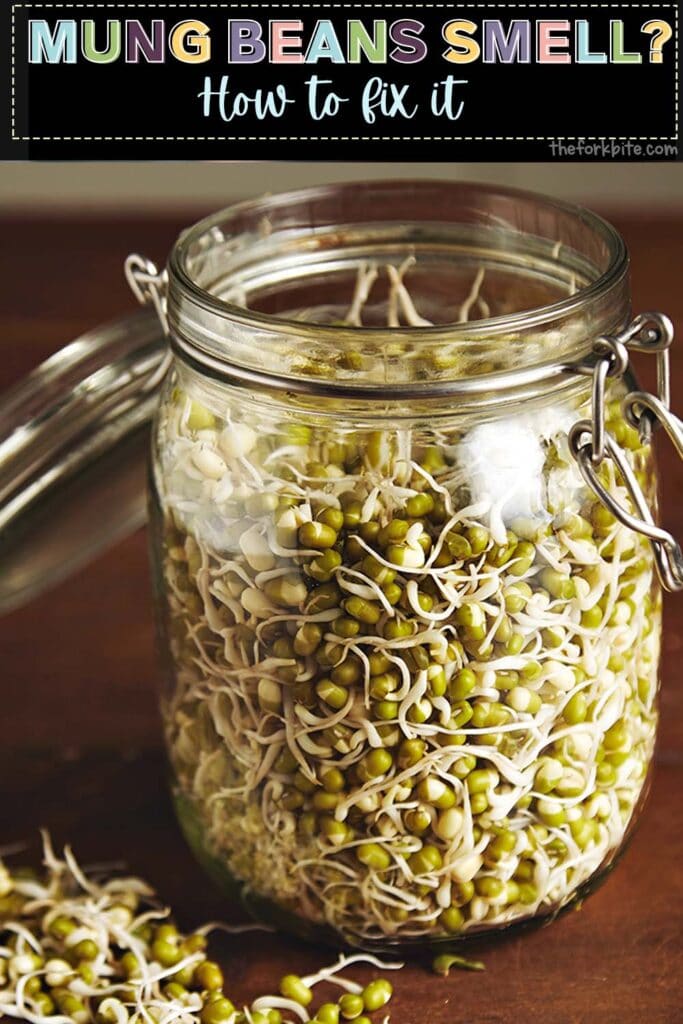Anyone who makes and eats sprouts will sometimes experience a foul mung bean sprouts smell. Many reasons like wrong sprouting conditions and improper storage lead to this foul smell.
If you are a sprouting enthusiast, you should know by now that mung bean sprouts smell is rather frustrating. It's quite similar to the smell of sulfur, rotten food, and even death. And it can be disgusting.
The good news is that there's a quick fix to the problem, where you will be able to start sprouting once again.
Read on to find out what I have to say about the cause of mung bean sprouts smell, what you can do to remove it and prevent future smelly sprouts.

Mung bean sprouts-What are they?
When we say bean sprouts, we typically refer to mung bean sprouts, they are tiny white shoots characterized by a ragged tail from the sprouted seed or germinating mung bean with two yellowish "horns" at the end.
They are available all year round and accessible to the pocket, making them an easy add-in to multiple Asian dishes.
All you have to do is soak them for a few hours and then drain and leave them to sit in a jar.
You will have to rinse them a few times a day, and they are perfect for chefs, healthy eaters, and home growers to make.
The off-white shoots are long and give a crunchy snap while biting into them in stir-fries or salad as a side vegetable. They, however, are rather bland in taste along. It's better to add some intense flavors to maximize its benefits.
Read: How to Grow Mung Bean Sprouts in a Jar
Types of sprouts/seeds
Bean sprouts also referred to as seed sprouts, sprouted beans, or sprouted seeds, are germinating forms of beans or seeds. They sprout the best in someplace warm and moist. It's the germinating shoot or sprout that you eat.
Commonly eaten sprouts (not a complete list):
- Beetroot
- Alfalfa
- Chickpeas
- Lentils
- Radish
- Garlic chive
- Chinese cabbage
- Broccoli
- Mung beans
- Fenugreek
- Onion seed
- Mustard
- Peanuts
- Green peas
- Rocket (rucola)
- Red cabbage
- Soya beans
- Wheatgrass kernels
- Sunflower seeds
What do mung bean sprouts smell like?
Mung bean sprouts won't smell much if you keep them clean, wash them regularly, and let them dry. They naturally have a slight, indistinct smell like any salad, and at the most, can be described as emitting an earthy aroma.
However, mung bean sprouts shouldn't have any nefarious smell like sulfur, rotting food, urine, or 'death'.
The only time mung bean sprouts smell like this is if you forget about them, they are left to sit for a long time. I strongly recommend throwing away the sprouts if they smell this bad and starting the entire sprouting process again.
Why do mung beans smell?
A few reasons lead to the mung bean smell. They include dampness, leaving the sprouts to sit for long periods, and letting bacteria and mold growth.
Most of the time, all it takes is good air ventilation and proper rinsing to prevent foul odors.
1 Over soaking
You should soak mung beans for only six to twelve hours. They are likely to rot if you forget and leave them soaked for long or use warm water.
Along with rotting, you will also notice foam formation on its surface.
I advise you to throw the mung beans if they start smelling and rotting. Then start again after thoroughly cleaning your equipment.
2 Poor rinsing the sprouts
You must rinse the sprouts at least twice a day upon starting the sprouting process and then leave to dry. They begin to break down and smell if you don't rinse them regularly.
3 Insufficient air circulation
You must leave the mung beans to drip dry after rinsing them. There should not be any water left in the container. There's a higher chance of the beans rotting if there is water.
I usually use a lid that lets the water drain and places the jar on a stand to tilt into a bowl. This lets the water drip out freely.
How can I sprout mung beans without a bad smell?
The following tips will help you produce mung bean sprouts without any smell:
1 Use a good quality lid
You must use a lid that lets all the water drains out of the jar. Don't forget to check the mesh grate's size too. There's a chance of it letting smaller beans fall into the drainage bowl If It's too small.
2 Keep cleaning the beans through the day.
Clean the sprouts at least twice a day with fresh water. Cover the sprouts with water and rinse each time thoroughly. This helps keep the mung beans fresh and clean so that you end up with scent and mold-free sprouts.
3 Good air ventilation
Poor airflow leads to the formation of moisture pockets and consequent mold growth. The best way to allow air circulation in the jar is by covering it with a mesh or holes.
And if you drip the sprouting beans into a bowl, placing the jar at the right angle provides maximum airflow than leaving it perpendicular.
4 Not too hot environment
Placing the sprouting jar in direct sunlight, near hot surfaces or in a hot part of the house only promotes mold growth.
It also next leads to rotting beans with an unpleasant smell. I always keep mung beans in the dark where there's good airflow.
Tips to prevent mung bean sprouts from going bad
There are a few things you can do in the preparation and sprouting stages to prevent the beans from rotting:
1 Proper location
Always place the sprouts somewhere out of direct sunlight, which only heats the sprouts. Leave it in a spot with good airflow to ensure the sprouts quickly dry out after washing.
There is a higher chance of bacterial growth and consequent mold in sprouts that sit in stagnant or hot water.
2 Frequent washing
Washing the sprouts thoroughly 2-3 times a day keeps them fresh. It also removes unwanted growths and helps the sprouts grow. The sprouts will become stagnant, smelly, and rotten if left without washing for a few days.
3 Consume after sprouting
It's always better to consume the sprouts once they have completed the sprouting process. Do not store them, and eat them for weeks together in the back of your fridge.
4 Thorough cleaning
Always give the sprouts a thorough cleaning before eating. Remember that they sit in the water while sprouting, thus making them sitting targets for potential bacterial growth, especially E-Coli.
So make sure you wash your sprouts, and if buying, buy only from reputable brands or suppliers.
Can sprouts cause food poisoning?
Yes, there are some cases where sprouts can cause food poisoning.
For example, the warm and moist condition is also the perfect environment for bacterial growth.
So these ideal growing conditions only help the harmful bacteria multiply in contaminated beans or seeds. Eating raw sprouts can eventually cause illness and possible food poisoning.
There is also the risk of contaminated Irrigation water or compost contaminating the sprouts if the sprouts are not grown hydroponically. However, cooking the sprouts before consumption removes any bacteria present.
What do I have to consider while buying sprouts?
There are a few things to look out for when buying sprouts:
- Make sure to store them in the fridge.
- Buy only crisp-looking sprouts.
- Avoid wilted or musty-smelling sprouts.
Always keep sprouts away from raw meats or seafood to prevent the possible transfer of any harmful bacteria from the meat or seafood onto the sprouts.
How do I store sprouts at home?
Always store the sprouts in the fridge as soon as you reach home. And consume before the best-before date. If the sprouts are not pre-packaged, use them within two days of buying.
However, throw away sprouts past their best-before date, and if they have lost their crispiness, look wilted or smell musty.
What is the safest sprouting procedure?
Always thoroughly wash your hands with warm water and soap before and after handling any food, including sprouted seeds. Thoroughly clean and rinse the sprouts under cool, running drinking water.
Make sure you wash all surfaces like chopping boards and utensils after preparation.
Ensure foods that aren't ready to eat, like raw meat, are not in any form of direct or indirect contact with the sprouts like through dirty hands, surfaces, or preparation equipment.
Is it safe to eat sprouts raw?
It is better if vulnerable people like the elderly, pregnant women, the very young, and those with a compromised immune system avoid eating raw sprouts.
The label should indicate if they are suitable for raw consumption or need cooking if buying the sprouts. It's always better to cook before eating if in doubt.
Can bean sprouts cause food poisoning?
There are some risks associated with eating bean sprouts, like reports of food poisoning, including E. coli, listeria, and salmonella.
It's because the sprouting conditions like sitting in stagnant water and ambient room temperature create the breeding ground for growth.
Is it possible to avoid food poisoning while eating sprouts?
Yes, you can avoid food poisoning by cooking the sprouts before eating. This simple but effective advice of increasing the sprout's temperature while cooking kills bacteria and reduces the risks of food poisoning.
Other tips worth following:
- Thoroughly wash the sprouts a few times a day.
- Ensuring there's no stagnant water.
- Washing well before cooking.
How to tell if bean sprouts have gone bad?
If your gut instinct tells you that the sprouts are bad, then don't even take a chance. Just throw them, wash the vessels and start all over again. You don't lose much, as sprouting is a cheap and simple process.
1 Foul smell
Mung sprouts are usually odorless, like any other salad ingredient. They will at the most emit an earthy smell. You know the sprouts have gone bad if they emit a pungent, sour, fishy, or any nefarious odor. You may also find a layer on the sprouts if you haven't washed them well.
2 Mold formation
You know the sprouts have gone bad if you find fuzzy mold clumps on them, most commonly a white, fuzzy layer. The sprout surface remains shiny or slightly reflective when correctly sprouted, without any covering or layer formation.
3 Funky taste
Properly sprouted mung beans just have a plain, snappy taste. Dispose of the sprouts immediately if they are chewy, sour, or soggy, as it means they have spoilt.
How long do bean sprouts last?
Depending on how you store them, they can last for a few weeks to several months.
Is it safe to eat bean sprouts if left unrefrigerated?
No, it is not recommended to leave grown bean sprouts unrefrigerated. It promotes mold growth and dramatically increases the risks of food poisoning. Also, do not store bean sprouts in ambient conditions.
How to make sprouts last longer
A few methods like placing the sprouts in the freezer or fridge help them last longer, without any foul mung bean sprouts smell. Of course, each option has its pros, cons, and shelf lives.
Take a look at them before selecting the best option for you.
1 Storing in the fridge
This is the simplest and most common means of storage. The sprouts can last between 2-6 weeks if properly stored.
How to properly store in the fridge
- Thoroughly rinse sprouts using freshwater
- Dry them using a rack, salad spinner, or towels because wet sprouts can trigger food poisoning
- Place sprouts in an airtight ziplock bag or plastic container
- Store in fridge
2 Storing in freezer
It's better to freeze large sprout batches if you plan to use them in stir-fries or meals infrequently. The sprouts can last for up to 3 months in the freezer.
Proper freezer storage methods:
- Boil a large pot of water
- Add and blanch the bean sprouts for 3-4 minutes
- Remove and add the sprouts to a large bowl of ice water
- Spread the sprouts on a baking sheet and place them in the freezer for 10-15 minutes
- Once hard externally, place the sprouts in an airtight container or zip lock bag and store
How to use leftover bean sprouts
You can do many things like trying out a new salad recipe, stir-frying, as a snack, or in a sandwich. Highly versatile, bean sprouts are great to create or top dishes.




